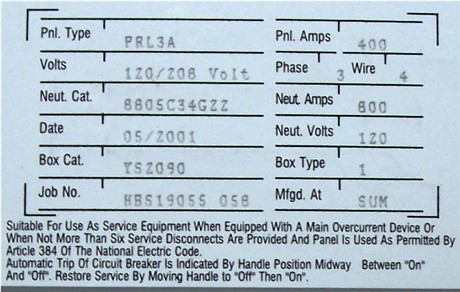4-25 Log #2156 NEC-P04 Final Action: Accept in Principle
(225.39)
______________________________________________________________
TCC Action: The Technical Correlating Committee understands that the
panel action on Proposal 4-22 adds the word ?calculated? to the wording
in this panel action.
Submitter: James Grant, Rochester, NH
Recommendation: Revise text to read:
225.39 Rating of Disconnect. The feeder or branch-circuit disconnecting
means shall have a rating of not less than the load to be supplied, determined in
accordance with Parts I and II of Article 220 for branch circuits, Parts III or IV
of Article 220 for feeders, or Part V of Article 220 for farm loads. Where the
branch circuit or feeder disconnecting means consists of more than one switch
or circuit breaker, as permitted by 225.33, the combined ratings of all the
switches or circuit breakers used shall be permitted. In no case shall the rating
be lower than specified in 225.39(A), (B), (C), or (D).
Substantiation: When using up to six disconnects, as permitted by 225.33, the
present wording requires all the disconnects to be rated at the value as
determined by 225.39. This revised article would directly parallel with 230.80.
For the same reason that 230 has it for calculating the service, it would allow
the value of some of the breakers to be used as the rating of the disconnect for
the feeder or branch circuit.
The panel?s statement to 4-36 Log #609 NEC-P04 in the 2005 report of
proposals made the following comment:
?Since a disconnect is a device or group of devices, permission is already
inherent to add each device to reach a total rating in compliance with this
section.? The new revised text will eliminate any confusion that there is
inherent permission for breakers to be additive in calculating the rating of a
disconnect.
Panel Meeting Action: Accept in Principle
Accept the added sentence with the exception of the word ?used? and revise
the proposed text by changing ?combined ratings of? to ?combining the ratings
of? and add the phrase ?for determining the rating of the disconnecting means?
to the text before ?shall be permitted? in the NEC to read as follows: ?The
feeder or branch-circuit disconnecting means shall have a rating of not less
than the load to be supplied, determined in accordance with Parts I and II of
Article 220 for branch circuits, Parts III or IV of Article 220 for feeders, or Part
V of Article 220 for farm loads. Where the branch circuit or feeder
disconnecting means consists of more than one switch or circuit breaker, as
permitted by 225.33, combining the ratings of all the switches or circuit
breakers for determining the rating of the disconnecting means shall be
permitted. In no case shall the rating be lower than specified in 225.39(A), (B),
(C), or (D)?
Do not revise any other text within this section.
Panel Statement: The word ?used? was deleted and text was added to the
proposed new sentence to provide clarity and to be more specific in what
constitutes the combined ratings of the disconnecting means for feeder or
branch circuit disconnecting means for separate buildings or structures.
Number Eligible to Vote: 10
Ballot Results: Affirmative: 10
_______________________________________


